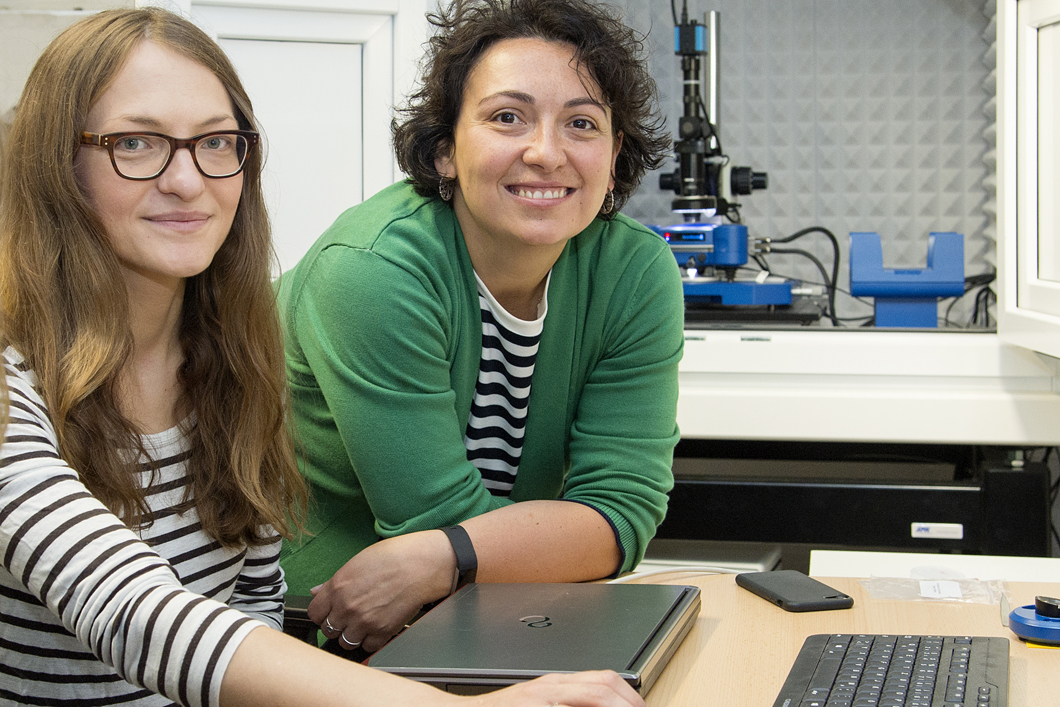
Dr.-Ing. Özlem Özcan with her colleague Dr. Julia Witt
Source: BAM
Dr.-Ing. Özlem Özcan is an expert when it comes to interfacial processes and corrosion. She joined the BAM three years ago – and has accompanied the development of the division of the same name from the very beginning. There is no end in sight to the foundational work as she and her colleagues will soon move into larger laboratories.
There were originally five members in the team, that number has since grown to 12. Engineers, postdoctoral scientists and students investigate together many different aspects of corrosion processes on surfaces and interfaces. The laboratories have expanded with new techniques, such as a high-resolution electrochemical microscope and an atomic force microscope with which materials can be examined under simultaneous corrosive and mechanical load.
What are these fancy methods used for? One of the aims is to investigate what damage microorganisms can do to metallic surfaces – and how quickly they carry out their destructive work. The team led by Dr.-Ing. Özlem Özcan works closely with the Division of Biodeterioration and Reference Organisms on this topic. One of the interdisciplinary projects is called Microbiologically influenced corrosion, or MIC for short. Research in this project focusses on how bacteria attach and adhere to metals, for example. The aim is to understand the mechanisms which lead to “biocorrosion”.
Localised corrosion can often develop under a biofilm and can be dangerous because the microbial catalysts thrive in oil pipelines, sewage treatment plant pipelines, food processing plants in the saline environment of offshore equipment or in ballast tanks on ships. “The challenge is to develop sensors which can differentiate between the progress of uniform and localised corrosion,” said Özcan. The aim is to develop corrosion sensors capable of detecting corrosion at its early phases to minimize safety risks. But she is starting with the fundamental aspects of corrosion and, put quite simply, she is watching the systems very carefully as they corrode.
Even “rustproof” stainless steels are susceptible to pitting corrosion. There is a particular demand for composite materials in all branches of industry, new alloys are constantly being developed to make structures lighter, stronger and more durable. “Methods which can simulate coupled load scenarios and shed light on damage mechanisms are important,” explained the scientist. This is what she is working on with her team. “This knowledge will help us to contribute to material safety,” she added.
And how do you become a corrosion expert? Özcan herself first trained to be a chemical engineer in Turkey and then came to Germany in 2006 to the Max-Planck-Institut für Eisenforschung in Düsseldorf, with a scholarship from the International Research School "SurMat". She defended her doctorate in the Faculty of Materials Science at the Ruhr-Universität Bochum. She continued investigating nanostructured thin films and lightweight materials for automotive applications at the Chair of Technical and Macromolecular Chemistry at Paderborn University before joining the BAM in April 2015. She will continue her research on corrosion processes for transportation applications by studying how hybrid components should be pretreated prior to joining in order to withstand both mechanical stress and corrosive load at the same time. The first projects are starting soon.


